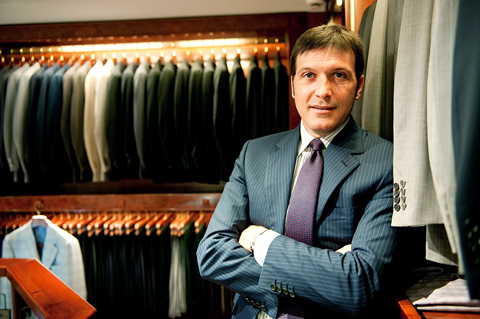Brioni, the go-to couturier for the likes of Donald Trump, Britain’s Prince Andrew and former South African president Nelson Mandela, has soldiered on through the global recession doing what it does best, producing hand-sewn bespoke suits for men.
Gaetano Savini, who co-founded the company with Nazareno Fonticoli in 1945, instilled “tenacity, and the vision that you have to dare to go beyond the rules of the game,” his grandson Andrea Perrone said.
Perrone, who became Brioni’s chief executive last year, said Savini was the first to stage a fashion show for menswear — in Florence in 1952 — and that Brioni was among the first to create fragrances for men.

PHOTO: AFP
“What I have maybe added is the idea of growing, with emerging markets like China, and to go beyond formal styles, the suit and tie,” Perrone said.
“With the crisis and customers who asked us for discounts or to pay in installments, we launched new categories of products with new fabrics,” he added, recalling an about-face from late 2008, “when the market was demanding more expensive, more luxurious garments.”
At first sight, the group’s main atelier in Penne di Pescara, on Italy’s Adriatic Coast, looks like a factory, but without machines.
Some 1,100 technicians and seamstresses ply their trade, designing patterns, cutting cloth with enormous scissors, sewing on a sleeve here, finishing a buttonhole there, or a hem ... then pressing carefully and checking their work.
“It takes us 18 to 22 hours to make a man’s suit, sometimes up to 48 hours,” chief master tailor Angelo Petrucci, 39, said.
By comparison, mass-produced suits take two to three hours to complete.
Each Brioni suitcoat counts between 5,000 and 7,000 stitches and is handled an average of 220 times — including 80 pressings.
“Even though we work by hand, we have specific time standards. For example, 15 minutes to insert a shoulder pad,” said Clementina Litillo, who at 57 is about to retire after 40 years.
The work is more complicated than a decade ago, Petrucci said, because clients are always after softer and finer fabrics.
Pointing out a lining consisting of camel, goat and horse hair, he said each creation has a “soul.”
Holding up a huge jacket created for a Japanese client, a former sumo wrestler, Petrucci said: “We can make obese people look thinner, short people look taller. We can even correct for bone defects by inserting all kinds of prostheses.”
Over the years, Brioni has built up a database to keep track of its clients around the world, many from the Middle East and Asia.
To be a good tailor, “you have to have sensitive hands, so you have to start very, very young,” Petrucci said. “After age 20, you can’t learn it.”
Petrucci himself started at age 13, when he began a four-year apprenticeship at Brioni.
The breeding ground of skill and talent shared among the technicians and seamstresses has been the secret of Brioni’s success, allowing it to survive a wave of retirements in the early 1990s just as sales were skyrocketing.
The global recession has not led to smaller price tags at the family firm, even though its annual turnover of about 200 million euros (US$265 million) shrank by 15 percent last year — 20 percent in the US.
A custom-made suit may cost up to 6,000 euros, while a fully personalized ensemble could cost as much as 30,000 euros.
“It’s not an expensive product, but a costly one, reflecting the hours and hours of work, but it can last more than 40 years,” Petrucci said.
In recent years, the group has diversified its range, offering lines for women and casual clothes, such as jeans and polo shirts, now nearly 40 percent of its sales.
The downside?
Sometimes Petrucci’s Blackberry will wake him in the middle of the night with an e-mail from a faraway client needing an emergency alteration.
Asked to describe the Brioni tailor of today, Perrone said: “When you think of a tailor, you think of a balding old man with little glasses leaning over his work. At Brioni, we have real managers, who travel, use new technologies, they’re tailors with Blackberries.”
Brioni has 65 stores around the world, with some new openings planned in the coming years.
The priority is China, “where we just opened a new store in Shanghai ahead of the Expo there, having opened a first store in Beijing a year ago,” Perrone said.
One thing Brioni does not worry about, whatever the state of the world economy, is advertising.
“Our best advertising is by word of mouth,” Perrone said. “Unlike other labels that try to make a new selling point out of an artisanal tradition, we don’t need to because it’s in our DNA.”

The US government has signed defense cooperation agreements with Japan and the Philippines to boost the deterrence capabilities of countries in the first island chain, a report by the National Security Bureau (NSB) showed. The main countries on the first island chain include the two nations and Taiwan. The bureau is to present the report at a meeting of the legislature’s Foreign Affairs and National Defense Committee tomorrow. The US military has deployed Typhon missile systems to Japan’s Yamaguchi Prefecture and Zambales province in the Philippines during their joint military exercises. It has also installed NMESIS anti-ship systems in Japan’s Okinawa

‘WIN-WIN’: The Philippines, and central and eastern European countries are important potential drone cooperation partners, Minister of Foreign Affairs Lin Chia-lung said Minister of Foreign Affairs Lin Chia-lung (林佳龍) in an interview published yesterday confirmed that there are joint ventures between Taiwan and Poland in the drone industry. Lin made the remark in an exclusive interview with the Chinese-language Liberty Times (the Taipei Times’ sister paper). The government-backed Taiwan Excellence Drone International Business Opportunities Alliance and the Polish Chamber of Unmanned Systems on Wednesday last week signed a memorandum of understanding in Poland to develop a “non-China” supply chain for drones and work together on key technologies. Asked if Taiwan prioritized Poland among central and eastern European countries in drone collaboration, Lin

BACK TO WORK? Prosecutors said they are considering filing an appeal, while the Hsinchu City Government said it has applied for Ann Kao’s reinstatement as mayor The High Court yesterday found suspended Hsinchu mayor Ann Kao (高虹安) not guilty of embezzling assistant fees, reducing her sentence to six months in prison commutable to a fine from seven years and four months. The verdict acquitted Kao of the corruption charge, but found her guilty of causing a public official to commit document forgery. The High Prosecutors’ Office said it is reviewing the ruling and considering whether to file an appeal. The Taipei District Court in July last year sentenced Kao to seven years and four months in prison, along with a four-year deprivation of civil rights, for contravening the Anti-Corruption

NO CONFIDENCE MOTION? The premier said that being toppled by the legislature for defending the Constitution would be a democratic badge of honor for him Premier Cho Jung-tai (卓榮泰) yesterday announced that the Cabinet would not countersign the amendments to the local revenue-sharing law passed by the Legislative Yuan last month. Cho said the decision not to countersign the amendments to the Act Governing the Allocation of Government Revenues and Expenditures (財政收支劃分法) was made in accordance with the Constitution. “The decision aims to safeguard our Constitution,” he said. The Constitution stipulates the president shall, in accordance with law, promulgate laws and issue mandates with the countersignature of the head of the Executive Yuan, or with the countersignatures of both the head of the Executive Yuan and ministers or